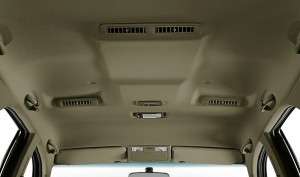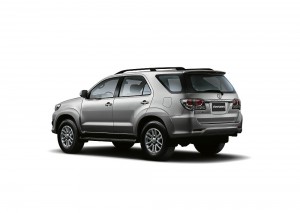
AIRCON vents are built into the headliner so all passengers can get that much-needed whiff of cold air.
The first time I drove the Toyota Fortuner was in March 2005 in Australia, where it was introduced to 50 selected Philippine, Thai, Indonesian and Malaysian motoring journalists. Manufactured and sold in Thailand starting in January that year, the first Fortuner was touted as a seven-seater urban sport utility vehicle suited for use as a passenger car although it shared the same platform as the 2005 Hilux pickup truck. The Fortuner completed the International Innovative Multi-Purpose Vehicle (IMV) series of Toyota together with the Innova and Hilux.
Grabbing the (right-hand-drive) wheel of a D-4D 4×4 common rail direct injection turbo intercooler diesel Fortuner, I discovered that despite its passenger car description, it ably tackled the easy and medium off-road courses in Darlington Park on the Gold Coast. However, driving the Fortuner on smooth, paved roads inside the park, I experienced the bouncy ride typically provided up front by a pickup truck chassis.
Improved riding comfort
Four months later in July 2005 when I had a D-4D Fortuner for one week’s test driving in Metro Manila and I once rode in the back while a friend took the wheel, I found that the ride quality on the rear seat was firm and not as bucking-horse bouncy as in the driver’s seat. Still, it wasn’t exactly car-like riding comfort.
So when the second generation Fortuner was launched at Toyota Motor Philippines’ 23rd founding anniversary celebration last month and TMP president Michinobu Sugata announced its “significantly improved riding comfort without sacrificing stability, durability and handling,” I promptly asked for a test drive. As it turned out, TMP gave Inquirer Motoring first dibs to the new Dsm-4D Fortuner and I was allowed to drive it for one day last week.
Validated
Taking the country’s second best-selling seven-seater SUV for a spin on the Skyway (I’ll leave the off-road testing to the all-terrain experts). I was pleased to validate Sugata’s “significantly improved riding comfort” announcement. Yes, it’s true: the 2011 D-4D Fortuner offers a much smoother and better ride quality up front than the original model. Maybe those who attended the launch event and listened closely to the technical presentation made by Toyota IMV chief engineer Koaru Hosokawa on the changes or additions made to the suspension can explain why. As for me, I believe in the saying that the proof of the pudding is in the eating.
With the caveat, however, that having the Fortuner for such a short time, I was unable to test its riding comfort seated in the back while someone else drove it. But judging from my experience as a rear seat passenger of the 2005 D-4D Fortuner, the riding comfort in the back should be even better than in front. Confirming this assumption will require another test drive.
What’s new
But a more comfy ride is not the only new thing in the second gen Fortuner. It has a new front grille, a new front bumper, new projector type HID headlamps with auto leveling and auto light control, new taillights plus new interior features. The powerplant remains the same in the D-4D variant: the 3.0-liter, direct injection, 4-cylinder-in-line DOHC 16 valve, Variable Nozzle Turbo with intercooler delivering 163 PS and 343 Nm max torque at 1,400-3,200 rpm via a gate-type 4-speed automatic transmission. The body structure, drivetrain, steering system, tires size, brakes and safety equipment also remain the same.
Meanwhile, in an effort to catch up with the competitor that has overtaken the Fortuner in sales, TMP is lowering the suggested retail price. Sugata announced at the launch event that the new Fortuner “will be competitively priced without compromising prestige or image.” There is much excitement as the face-lifted 2011 Fortuner tries to recover pole position in the SUV race with its improved ride quality and lower retail price.


